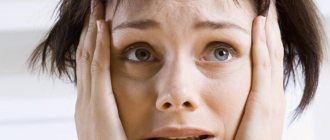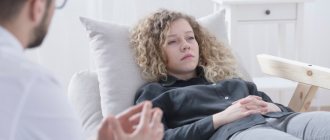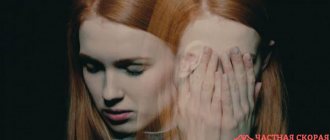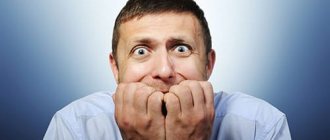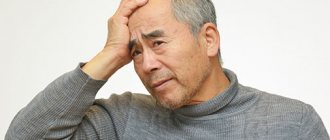The relevance of the problem of studying tic hyperkinesis is determined by the fairly high prevalence of this pathology in children. Thus, American researchers A. Shapiro and E. Shapiro [18] cite the prevalence of tics in children as 24%, R. Kurlan [16] - 21%. But J. Jankovic [13] gives a significantly lower figure - 4%, indicating that tics are somewhat more common at the age of 6-7 years - 10%; Swedish researchers N. Khalifa and A. von Knorring [14] discovered tics in 6.6% of schoolchildren aged 7 to 15 years.
According to modern concepts, various factors play a role in the occurrence and development of tics: genetic, psychological, as well as organic damage to the brain in the perinatal period [11, 13]. The clinical and social significance of tics is determined not only by hyperkinesis itself, but also by comorbid cognitive and behavioral disorders (attention deficit hyperactivity disorder, anxiety disorders, obsessive-compulsive disorders) [10].
Previous studies on tics focused mainly on disease-specific manifestations without taking into account the clinical polymorphism of this disorder.
According to ICD-10, transient and chronic tics are distinguished. Chronic tics (F.95.1) are a more severe variant of the disease. They occur many times during the day, almost daily or intermittently, for a year or more. More often we are talking about motor tics, vocalizations are less common. These tics can remain stable for many years, only fluctuating in the degree of their severity [3]. Increased hyperkinesis in these cases may be observed during periods of stress or fatigue. According to J. Scharf et al. [17], chronic tics occur in 1.1% of children.
According to V.P. Zykov [2], depending on the course, 3 types of course of chronic tics can be distinguished: remitting, stationary and progressive. For relapsing
The course of the disease is characterized by the alternation of exacerbations of tics by complete regression of symptoms or local single tics in the home environment.
Remissions in most patients occur in the summer months, exacerbations - in the autumn and winter months, which is associated with mental stress during training. The more severe the tics, the longer the exacerbations and the shorter the remissions, which is especially pronounced in patients with a hereditary genesis of the disease. The stationary
type of the disease is determined by the presence of persistent hyperkinesis of various muscle groups, which persist for 2-3 years.
The progressive
course is characterized by the absence of remissions, the transition of local tics to widespread tics and Tourette's syndrome, the complication of stereotypies and rituals, the development of tic status, and resistance to therapy.
Nootropic drugs (Pantogam, Phenibut) and antipsychotics (haloperidol, tiapride) are traditionally used to treat tics [1, 9, 13]. It should be noted that the latter often cause complications (extrapyramidal disorders, hypersomnia). The presence of comorbid cognitive impairments necessitates their correction and, accordingly, the development of new treatment methods.
In 2009, the authors [8] demonstrated the possibility of using the drug adaptol effectively in the treatment of tics. However, in the previously treated group of patients (30 children), there were few (13) patients with chronic tics, which is not enough to reliably assess the effectiveness of adaptol in these cases.
The purpose of this study is to continue studying the clinical and psychophysiological characteristics of various tics in children and to increase the effectiveness of the use of adaptol in the treatment of their chronic variants.
Dietary supplements inexpensively
COVID-19 is an acute respiratory disease caused by a new strain of coronavirus, SARS-CoV-2. The virus was first identified at the end of 2021 in the Chinese city of Wuhan and since then has been actively spreading throughout the world, causing a pandemic.
The virus spreads quite quickly. It is transmitted from a sick person to a healthy person by airborne droplets (infectious particles are released when sneezing and coughing), or by contact (by contact with surfaces contaminated with respiratory secretions). Research is still being conducted on how quickly the virus can spread and in what other ways this can happen. However, experts already claim that carriers of the virus are infectious not only with symptoms of the disease, but also pre-symptomatic and asymptomatic individuals.
Treatment of covid pneumonia
Treatment of covid pneumonia in the clinic and at home. What you need to know about the disease. Recommendations from experienced doctors. Consequences of coronavirus. When to call a doctor.
More details
Call a paid therapist for coronavirus
If the Covid test shows a positive result and your condition is stable, you can call a therapist at your home in Moscow. MC "KORSAKOV": high-quality treatment of coronavirus at home.
More details
Covid test
Do you suspect coronavirus? Take a Covid test right at home. The accuracy of the results is more than 95%. All types of tests for covid. We work around the clock.
More details
Covid smear
A Covid smear is a quick and accurate way to diagnose coronavirus. Get tested without leaving home. Get results within 1 day.
More details
PCR for Covid
Do you suspect that you have become infected with coronavirus? PCR testing for Covid can be done at home. Specialists arrive at any time. Fast, reliable, inexpensive.
More details
Paid hospitalization for Covid
Are they being sent to a hospital for treatment of coronavirus? Paid hospitalization for Covid – high-quality medical care at affordable prices. Fast, safe, around the clock.
More details
Transporting a patient with Covid
Don't risk your health and the health of others! Transporting a patient with Covid in an ambulance is the optimal solution to the problem at an affordable price.
More details
Characteristics of Atarax
The active ingredient of the drug is hydroxyzine. It acts by blocking H1-histamine receptors and affecting some subcortical structures of the brain. The drug prevents the appearance of vomiting, soothes, and reduces the symptoms of urticaria. Hydroxyzine improves cognitive functions of the brain. Can be used for a long time, because not addictive. After taking it, sleep improves, anxiety disappears, and muscle tension decreases.
During treatment, headache, drowsiness, dry mouth, tremor, and dizziness may occur. There is a decrease in blood pressure, nausea, allergies, constipation, vomiting, and kidney and liver dysfunction. The product begins to act within 30-50 minutes. The blood value reaches its maximum after 1-2 hours. The active substance is distributed more in tissues than in the blood. It undergoes biotransformation in the liver with the formation of the main metabolite - cetirizine. Within 14 hours, half is excreted in the urine.
Taking the drug is contraindicated if you are allergic to cetirizine or hydroxyzine, porphyria, pregnancy or breastfeeding.
Children under 3 years of age are prohibited from prescribing medicine in tablet form. It is necessary to limit intake in case of myasthenia gravis, vision problems, seizure disorders, water and electrolyte imbalance, hyperthyroidism and severe cardiovascular diseases.
Clinical manifestations of coronavirus
People with coronavirus may have only partial symptoms or no symptoms at all. But most patients experience the following symptoms:
- Increase in body temperature to 37-39 degrees Celsius;
- Feverish state;
- Pain throughout the body, aches, severe weakness;
- Fatigue;
- Shortness of breath and difficulty breathing;
- Loss of smell and taste;
- Headache;
- Conjunctivitis;
- Myalgia;
- A sore throat;
- Nasal congestion (usually without runny nose);
- Nausea, vomiting, digestive system disorders (uncommon).
The incubation period for coronavirus ranges from 2 to 14 days. Symptoms usually appear suddenly, most often on the 7th day. In most cases, the disease occurs in mild to moderate form, and patients are treated on an outpatient basis. The risk of developing complications and severe disease increases with age, in the presence of chronic diseases, immunodeficiency conditions, mental disorders, obesity, problems with the heart, kidneys, and lungs.
Severe forms of coronavirus are characterized by shortness of breath, lack of air, hypoxia, and extensive lung damage, which can lead to respiratory failure, shock, multiple organ failure, and premature death. When the disease is severe, a person often requires oxygen support or connection to a ventilator.
Coronavirus can also cause serious problems such as heart disease (arrhythmia, cardiomyopathy, acute heart injury), coagulation disorders (thromboembolism, arterial clot formation, hemorrhage), sepsis, shock.
But in addition to the above symptoms, COVID-19 can also cause serious disturbances in a person’s psycho-emotional state. One of the most common problems is the occurrence of panic attacks in people who have had coronavirus.
Why do panic attacks occur after coronavirus?
Panic attacks are a neurotic disorder characterized by attacks of unreasonable anxiety and severe fear, combined with somatic manifestations. The causes of panic attacks are still not fully understood, but it is known for sure that they arise as a result of severe emotional shock or stress (excessive physical activity, pregnancy, stress, illness).
Coronavirus has become a real challenge for many. Fear of getting sick, severe illness, long-term treatment, forced self-isolation, fear of losing a job and source of income, loss of a loved one due to complications due to coronavirus - all this has a negative impact on the people’s psyche. For many, the pandemic has become a real shock, the consequences of which people have been struggling with for a long time. Statistics show that one of the most common problems that arise after coronavirus is panic attacks - a peculiar consequence of COVID-19, a reaction to stress. Mostly young people aged 20-30 years and in most cases women are susceptible to this neurotic disorder.
Symptoms of a panic attack
- Severe groundless fear, panic and horror;
- Chest pain;
- Difficulty breathing, feeling of lack of air;
- Increased pulse and heart rate;
- Chills, trembling in the body;
- Blood pressure surges;
- Dizziness;
- Fogginess, confusion, loss of sense of reality;
- Fear of going crazy or dying.
Additional symptoms may be: frequent urination, stool disorders, increased sweating, a feeling of a lump in the throat and tightness in the chest, cramps in the limbs, impaired motor function, insomnia.
The duration of one panic attack ranges from several minutes to several hours (most often up to 30 minutes). The attack usually begins suddenly under the influence of an external irritating factor - a situation in which the patient experiences discomfort, for example, while traveling in transport, air travel, being in a crowd, etc. Depending on the severity of the disease, panic attacks can occur 1-2 times a month up to several times a day.
Panic disorder is not limited to one attack. The first episodes frighten a person so much that he begins to anxiously await the onset of the next attack. This further increases emotional stress, making the situation worse.
At the same time, panic disorder is not always an independent disorder, but may be a manifestation of another disease, for example, heochromocytoma, somatoform dysfunctions, depression, phobic disorders, post-traumatic stress disorder, diseases of the endocrine, cardiovascular system, due to taking medications, etc. Panic attacks , developing after coronavirus, experts classify as disorders that arise against the background of stress and a high drug load on the body.
Why are panic attacks dangerous?
Panic and anxiety attacks, when repeated frequently, can cause death. When the first symptoms of this neurological disorder appear, you should seek help from a specialist. Otherwise, there is a risk of developing phobias, when, in anticipation of a new panic attack, a person will consciously avoid people, public places, and transport. Fear of a panic attack can lead to conscious reclusiveness.
Panic attacks can cause the following complications:
- Depression;
- Asthenia;
- Sleep disorders (insomnia, shallow sleep, nightmares);
- Neurasthenia;
- Phobic disorders;
- Neuroses.
Lack of timely medical care for panic attacks can lead to a personality disorder from which the patient will no longer be able to get rid of. Some patients with frequent panic attacks may deliberately refuse food, which leads to dystrophy and diseases of the internal organs.
Treatment of covid (COVID-19) at home
Call a narcologist Call a psychiatrist
Call an ambulance Call an emergency service
A person withdraws into himself, not understanding how to get rid of panic attacks, he becomes depressed, does not believe that anyone can help him, refuses psychological help and may attempt suicide.
Treatment of panic attacks in patients after coronavirus
Panic attacks themselves do not threaten a person’s life, but without proper medical care, their frequency and intensity increases, the intensity of the manifestation of somatic disorders increases, which significantly worsens a person’s quality of life.
Treatment of panic attacks has a positive prognosis, provided that you consult a doctor in a timely manner. Complex therapy allows you to reduce the frequency and intensity of attacks, and then completely rid the person of the problem. The most pronounced effect is achieved when using an integrated approach - prescribing drug maintenance therapy, psychotherapy and physiotherapeutic treatment to the patient.
The treatment of panic attacks in patients after coronavirus is somewhat different from the treatment of panic attacks in other patients. After Covid, a person’s body is very weakened, he needs more time to recover from the illness. If the coronavirus was in moderate or severe form, then the patient probably received treatment with antibiotics, immunomodulators, antitussives, antiallergic drugs, and took vitamin complexes. It is necessary to prescribe drugs to such a patient to correct the mental state carefully, strictly according to indications and taking into account contraindications and possible side effects.
Drug treatment for panic attacks
There are two types of medications for the treatment of panic attacks: for quick help during an attack (act instantly) and medications for continuous use (preventive).
The first group includes benzodiazepine tranquilizers (alprazolam (Xanax), clonazepam, diazepam (Relanium), phenazepam). These are potent prescription drugs that are not commercially available. They quickly relieve an acute condition, relieve anxiety and eliminate vegetative manifestations during an attack. Such drugs are used once as an emergency aid to a patient who has a severe panic attack, or in short courses. Long-term use of benzodiazepine tranquilizers causes persistent mental dependence in the patient and forms tolerance to the drug - the need to increase the dose to obtain an effect.
Non-benzodiazepine tranquilizers (hydroxyzine (atarax), mebicar, etifoxine, meprobamate) have a less pronounced effect compared to benzodiazepine drugs, do not cause addiction, are well tolerated by the patient, and can be used both once and systematically to prevent panic attacks.
Neuroleptics with a sedative effect are drugs that can eliminate feelings of anxiety and stop a panic attack. The most commonly used are Thioridazine (Sonapax), Periciazine (Neuleptil), Chlorprothixene (Truxal), Quetiapine (Seroquel), Alimemazine (Teraligen), Sulpiride (Eglonil). The disadvantage of this group of drugs is that not only the feeling of anxiety is suppressed, but also other feelings - joy, surprise, curiosity, etc.
Antidepressants with sedative effects are used as first aid and to prevent panic attacks. The effect develops gradually, but is long-lasting.
Normotics - allow you to restore the balance between the processes of excitation and inhibition of the nervous system. Widely used in the treatment of panic attacks in people with brain injuries, stroke survivors, and hypoxia.
Drug treatment should be prescribed by an experienced doctor, taking into account the overall clinical picture, collecting anamnesis, assessing all the risks and the expected result.
Psychotherapy in the treatment of panic attacks after covid
All over the world, cognitive behavioral psychotherapy is recognized as the most effective in treating panic attacks. This method of psychotherapeutic influence allows one to achieve positive results in a relatively short time (6-12 sessions), enhance the effect of drug treatment or completely eliminate the need for pharmacotherapy.
The psychotherapist, using special tests and techniques, determines the root cause of the disorder, identifies the triggers of panic, explains to the patient what is happening from a scientific point of view (psychoeducation of the patient), identifies erroneous ideas about panic, helps to divide the individual’s emotions into productive and unproductive, and as a result, change the patient’s idea of situations and about your condition. The duration of the course of psychotherapy is determined for each patient individually. Treatment is anonymous.
Physiotherapeutic methods for treating panic attacks
Physiotherapeutic treatment for panic attacks after coronavirus in combination gives good results. COVID-19 in most cases affects the upper and lower respiratory tract, causing complications on the nervous system, musculoskeletal system, and cardiovascular system. Physiotherapeutic procedures allow the body to recover faster from illness, correct the psychophysical state, normalize the functioning of internal organs, and improve blood formation processes.
Write to WhatsApp
COST OF TREATMENT
In medicine, the following methods of physiotherapeutic treatment are used to treat panic attacks and other mental disorders in patients who have suffered from coronavirus:
Xenon therapy - inhalation of the inert gas xenon mixed with oxygen through an inhalation mask. Xenon has sedative, hypnotic, analgesic, and regenerating properties. The gas is non-toxic, does not cause allergic reactions, and is quickly eliminated from the body unchanged through the lungs. Xenon therapy accelerates the process of oxygen saturation of the blood, improves metabolic processes at the cellular level, helps restore the functioning of the respiratory system, including after covid pneumonia, bronchitis, tracheitis, etc. During panic attacks, xenon helps to quickly relieve nervous tension, correct the psycho-emotional state, and normalize dream. In combination with drug therapy, inhalation of a xenon-oxygen mixture can achieve lasting results. The duration and intensity of the xenon therapy course is determined by the doctor for each patient individually.
Heliox - inhalation of a helium-oxygen mixture heated to the optimal temperature. Helium is an inert gas, tasteless, colorless and odorless. Heliox today is widely used for the treatment of pulmonary, cardiological and ophthalmological diseases, for removing a person from hypoxia and hypothermia, for the treatment of alcohol and drug addiction. Helium inhalations allow better transport of oxygen to brain cells, into the cells of the lower respiratory tract, and normalize blood supply to the brain. Helium-oxygen inhalations are one of the best solutions for recovery after coronavirus and for the treatment of panic disorders, as they have a regenerative and sedative effect. The required number of Heliox sessions is determined for each patient individually.
Ozone therapy intravenously (drip) is a therapeutic method that has many therapeutic effects. Intravenous injections with saline solution enriched with ozone have antiviral, antibacterial, anti-inflammatory, and antioxidant effects. Ozone therapy is actively used in medicine to treat diseases of the cardiovascular system, neurological diseases, problems of the gastrointestinal tract, gynecological and urological diseases and diseases of the ENT organs. Ozone therapy allows you to restore the functioning of all organs and systems of the body after coronavirus, strengthen the immune system, and improve the functioning of the central nervous system. The procedure is carried out strictly according to indications.
ILBI (intravenous laser blood irradiation) is a method of light therapy, which is based on the impact on human blood cells with a special LED sensor inserted intravenously using a thin needle. Low-intensity laser irradiation is applied to blood cells directly in the vascular bed. ILBI has a powerful sanogenic effect, allows you to systemically increase immunity and restore the body. In addition, ILBI has a beneficial effect on the hematopoiesis process, changes the composition of plasma, rheological properties, which is useful after surgery, severe respiratory diseases, after infections, etc. The ILBI procedure is prescribed exclusively by a doctor based on a study of the patient’s medical history, clinical picture and assessment general psycho-emotional state of the patient.
Electrosleep is one of the most widely used electrotherapy methods. It is based on the use of pulsed low-frequency currents that affect the central nervous system, causing its inhibition and, as a result, a state close to sleep. To carry out the procedure, a special device is used that converts the current into pulses. The impulses have an effect directly on the cerebral cortex and subcortical formations of the patient. The procedure allows you to restore emotional, vegetative and humoral balance, normalizes higher nervous activity, and has a sedative and hypnotic effect. Electrosleep also has a positive effect on the process of hematopoiesis in the body, improving blood clotting and lowering cholesterol levels in the blood. The procedure improves carbohydrate, lipid, protein, mineral metabolism, and accelerates regeneration processes. Electrosleep treatment is recognized as one of the safest. It is prescribed to children from 3 years of age, as well as pregnant and lactating women. This method of therapy is effective in the treatment of panic attacks of any etiology, including after coronavirus infection.
Treatment of panic attacks after coronavirus at the KORSAKOV clinic
In medicine, modern pharmacological, psychotherapeutic and physiotherapeutic methods are used to treat panic attacks and anxiety disorders that occur after coronavirus. Therapy is carried out around the clock in the hospital, on an outpatient basis and at the patient’s home, while maintaining the anonymity of clients.
The clinic employs highly qualified therapists, psychiatrists, psychotherapists, physiotherapists, narcologists, resuscitators, who are ready to take on the most difficult cases to help a person return to a full social life. The cost of services is fixed.
You can ask any questions you may have by calling the hotline of the KORSAKOV clinic +7 (499) 288-19-74.
Material and methods
We observed 162 patients with various tics; There were 133 boys (82.1%), 29 girls (17.9%), the average age of the children was 12.4±2.1 years (range from 10 to 15 years).
In accordance with the ICD-10 criteria, the subjects were divided into two groups: the first group consisted of 80 children with chronic tics; the second - 82 patients with transient tics. The control group consisted of 40 healthy children 10-15 years old.
The diagnostic examination included a clinical assessment of the manifestations of tics, a neurological examination, electroencephalography, and a psychological study.
Average tic frequency was calculated using the 5-point Tourette's Syndrome Global Scale (TSGS) tic frequency scale. The severity of attention deficit hyperactivity disorder (ADHD) was also identified and assessed using the SNAP-IV scale [19].
The level of attention was assessed using the psychophysiological test TOVA (The Test of Variables of Attention), based on presenting the subject with significant and insignificant visual stimuli in the form of geometric figures and allowing the state of attention to be assessed in relation to normative data. TOVA data include assessments of inattention (errors of omission of significant stimuli), impulsivity (errors of false button presses), speed of information processing (response time), and attentional stability (response time dispersion). The test requires the patient's attention for 22.5 minutes, divided into 2 halves [12].
The level of anxiety was determined using the anxiety questionnaire developed by S.M. Zelinsky and V.E. Kagan based on the Taylor and Sarason scales [5].
EEG recording was carried out on a 21-channel digital encephalograph. Routine (visual) EEG analysis included an assessment of the general functional state of the brain, the level of maturity of the bioelectrical activity of the brain and the correspondence of its nature to the patient’s age; determination of the localization of pathological changes and their severity. In the spectral analysis of the EEG, special attention was paid to the spectral power of the α-rhythm in the occipital leads, and the ratio of the θ-rhythm and β1-rhythm in the frontal leads was calculated before and after the course of treatment.
When studying the effectiveness of adaptol, a group of children with chronic tics was divided into two subgroups - the main and comparison groups: patients of the main subgroup (40 children) received adaptol for 60 days at a daily dose of 1000 mg (in 2 doses of 500 mg in the morning and evening ); patients in the comparison subgroup (40) received the drug Pantogam, traditionally used to treat tics, at a daily dose of 1000 mg per day (in 2 doses of 500 mg in the morning and afternoon).
Characteristics of Phenibut
The active component in the composition is aminophenylbutyric acid. It facilitates the transmission of impulses between GABA receptors. There is an improvement in bioenergetic processes in the brain. After taking the product, tension, fear, and anxiety disappear. Sleep becomes much stronger, insomnia in adult patients, including the elderly, is eliminated.
Manifestations of asthenic syndrome such as headache, dizziness, irritability, and inability to concentrate disappear. Phenibut improves the cognitive abilities of the brain, such as memory, attention, reaction speed.
During therapy, drowsiness, headache, irritability, nausea, allergies, and increased anxiety occur. The product is quickly absorbed and penetrates all tissues of the body. Biotransformed in the liver, excreted in the urine and does not accumulate in tissues. It is contraindicated to take the drug if you are allergic to the active ingredients. It is necessary to limit intake during pregnancy and breastfeeding, gastrointestinal ulcers, insufficiency of liver and kidney function.
Phenibut improves the cognitive abilities of the brain, such as memory, attention, reaction speed.
Reviews from doctors
Anatoly, 43 years old, Ryazan: “I often use both drugs to treat alcoholism in patients. The drugs rarely cause unwanted reactions, are well tolerated by most patients, and are effective. I prescribe these medications for a number of other pathologies. Children can be prescribed both at once if they have stuttering, nervous tics, or frequent hysterics. Most often, people easily tolerate either a single dose or a combination.”
Inga, 34 years old, Moscow: “I often prescribe medications both separately and simultaneously. Atarax is a weak tranquilizer, it helps with neurotic disorders, irritability, aggression; drowsiness does not occur when taken. Phenibut is a more powerful and specific drug; adverse reactions when taking it are observed more often. I can prescribe 2 medications at once if the patient has alcohol dependence, severe anxiety, and neurotic disorders.”
Which is better Atarax or Phenibut?
To improve memory, attention and overall performance of the body, you can take Atarax or Phenibut. Atarax is prescribed more often to eliminate aggression and anxiety, skin itching and rashes. Phenibut is suitable for patients with mood swings and reduced mental performance.
Atarax is prescribed more often to eliminate aggression and anxiety, skin itching and rashes.
For hyperhidrosis
Phenibut is prescribed because Atarax has increased sweating on the list of side effects. In the absence of individual hypersensitivity of the body to hydroxyzine, you can take it according to indications.
For children
Patients in this category are prescribed Phenibut because it has fewer side effects and is better tolerated by the body.
For sleep
Phenibut is used to treat insomnia, although with psychomotor agitation, Atarax can be used to fall asleep.
With VSD
Phenibut is prescribed to improve cerebral circulation, eliminate tension and anxiety.
